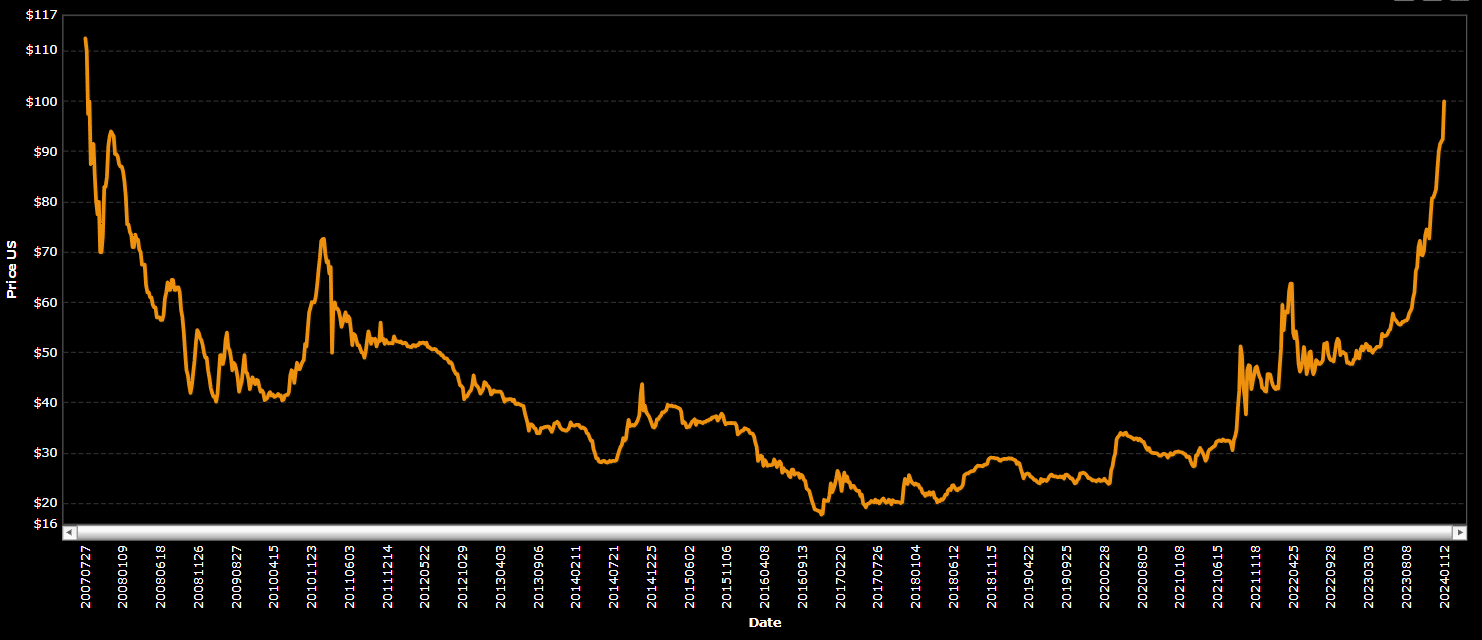Spot uranium prices recently reached a peak not witnessed since 2007, standing strong at $101 per pound, per Numerico data.
This upswing signifies a constrained nuclear fuel market, growing expectations for future demand, and the imperative for additional mine restarts and new constructions, according to experts in the uranium industry.
Uranium is Powering Up the Future
The surge in uranium prices aligns with an increased focus on nuclear energy in global climate change mitigation efforts. Furthermore, rising uranium prices have spurred the revival of uranium mining operations previously scaled back following the 2011 Fukushima disaster.
Analysts and industry players anticipate more mine restarts in 2024. Plus, new builds are getting more attractive due to rising prices and anticipated supply deficits over the coming years.
The spot price of uranium surging $100/pound was more than a 100% increase from the 2023 low. It is also a whopping >300% rise from the 2020 low.
Uranium Spot Price USD Per Pound

The 16-year high uranium price, cracking at $101/pound since 2007, is driven by several factors.
For one, shortage in uranium supplies since the Fukushima incident drove prices upward.
Moreover, a U.S. bill seeking to ban nuclear fuel imports from Russia further contributes to the prices’ upward trajectory. The bill was called “NO RUSSIA” – National Opportunity to Restore Uranium Supply Services In America Act of 2022. Put simply, Russia will be out of the U.S. uranium market.
- RELATED: BREAKING: The US House Passed a Bill that just Repatriated the Nuclear Cycle from Russia’s Control
Once the bill passes the Senate, near-term demand for uranium will further surge upward.
What Causes the Unprecedented Rise of Uranium?
But what are the market experts saying about this price breakthrough?
According to a uranium market analyst, Marin Katusa, the 16-year high uranium price reflects the “real” cost of bringing on previously built and permitted facilities to replace uranium exported from Russia and Niger.
Marin also noted that with the US banning Russian imports, the logical investment is exposure to permitted, built out production in the US. The banned imports include Kazakh production owing to Russian enrichment.
Uranium prices have to increase more, Marin further noted, to incentivize new projects like the case with the Athabasca Basin. Building a new mine in North America would need even higher prices than $100.
Highlighting the growing demands for clean energy from data centers, which require more power for new technologies, SMR technologies offer a promising solution.
Small modular reactor development, with under 300 MWe capacity, is taking place in Western countries with increasing private investment. North America, in particular, would be the epicenter of this rapidly growing nuclear resurgence.
Marin also highlighted Japan’s decision to bring on the world’s largest nuclear power plant and its pro-nuclear stance since Fukushima. This and the positive outlook for nuclear technology globally coming out of the recent COP28 climate summit will create new demand for long term supply of uranium in politically stable jurisdictions. After all, Marin said that:
“…no nation wants to experience what France is experiencing in Niger with their uranium supply being completely cut off.”
For Miss America 2023, Grace Stanke, who happens to be a student of nuclear engineering, nuclear energy already plays a big role in the lives of many Americans. As a nuclear champion, Grace particularly noted that:
“From curing my dad’s cancer twice, to powering 20% of America, to helping with agriculture which is so important in my home state of Wisconsin… it really does feel like nuclear does it all.”
Beyond the Price: Uranium’s Ascent and Nuclear Energy Resurgence
As the world strives to reduce carbon emissions, zero-carbon nuclear energy is crucial. This is expected to make the demand for uranium explode much more.
In effect, escalating spot uranium prices may also exert upward pressure on contract prices as sellers seek higher returns. While higher prices may not dissuade utilities for short-term needs, climbing contract prices, covering larger quantities of uranium, could have a more substantial impact.
Some utilities are already experiencing “sticker shock”, as seen below in the S&P Global presentation. Experts also anticipate a widespread increase in nuclear fuel costs in the coming years due to rising market prices.
Notably, higher uranium prices would also drive further restarts in the near term, with industry giants like NAZ Kazatomprom JSC and Cameco restarting idle capacity. Canada-based Cameco will add capacity as needed under long-term contract pricing.
Meanwhile, Kazakhstan-based Kazatomprom, the largest uranium producer, plans to return to full production capacity by 2025. However, given the challenges that the company faces related to the availability of sulphuric acid (a critical operating material), they expect adjustments to their 2024 production plans. They also anticipate delays in finishing construction works at their newly developed deposits. These may affect Kazatomprom’s 2025 production plan, subject to considerable supply chain risks.
The surge in uranium prices signifies a resurgence in the nuclear energy sector. Driven by geopolitical shifts, legislative actions, and a growing demand for clean energy, the uranium market is poised for unprecedented growth.


